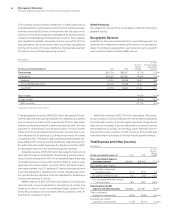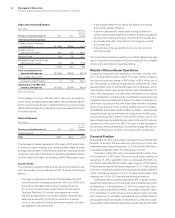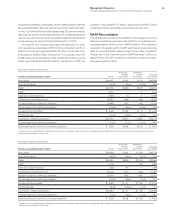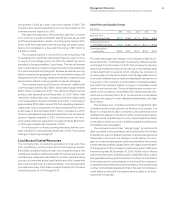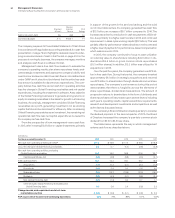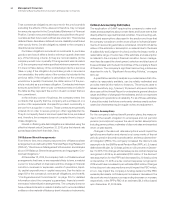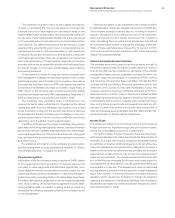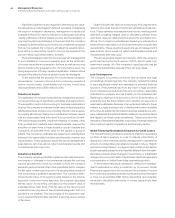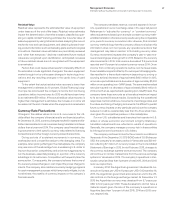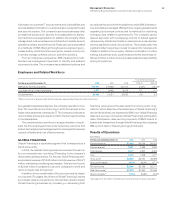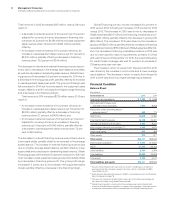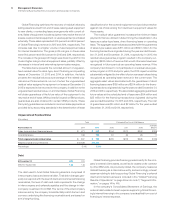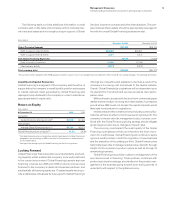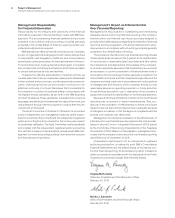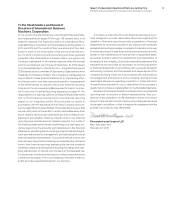IBM 2015 Annual Report Download - page 68
Download and view the complete annual report
Please find page 68 of the 2015 IBM annual report below. You can navigate through the pages in the report by either clicking on the pages listed below, or by using the keyword search tool below to find specific information within the annual report.66 Management Discussion
International Business Machines Corporation and Subsidiary Companies
Significant judgment is also required in determining any valua-
tion allowance recorded against deferred tax assets. In assessing
the need for a valuation allowance, management considers all
available evidence for each jurisdiction including past operating
results, estimates of future taxable income and the feasibility of
ongoing tax planning strategies. In the event that the company
changes its determination as to the amount of deferred tax assets
that can be realized, the company will adjust its valuation allow-
ance with a corresponding impact to income tax expense in the
period in which such determination is made.
The consolidated provision for income taxes will change period
to period based on nonrecurring events, such as the settlement
of income tax audits and changes in tax laws, as well as recurring
factors including the geographic mix of income before taxes, the
timing and amount of foreign dividend repatriation, state and local
taxes and the effects of various global income tax strategies.
To the extent that the provision for income taxes increases/
decreases by 1percent of income from continuing operations
before income taxes, consolidated net income would have
decreased/improved by $159million in 2015.
Valuation of Assets
The application of business combination and impairment account-
ing requires the use of significant estimates and assumptions.
The acquisition method of accounting for business combinations
requires the company to estimate the fair value of assets acquired,
liabilities assumed, and any noncontrolling interest in the acquiree
to properly allocate purchase price consideration between assets
that are depreciated and amortized from goodwill and indefi-
nite-lived intangible assets. Impairment testing for assets, other
than goodwill and indefinite-lived intangible assets, requires the
allocation of cash flows to those assets or group of assets and
if required, an estimate of fair value for the assets or group of
assets. The company’s estimates are based upon assumptions
believed to be reasonable, but which are inherently uncertain and
unpredictable. These valuations require the use of management’s
assumptions, which would not reflect unanticipated events and
circumstances that may occur.
Valuation of Goodwill
The company reviews goodwill for impairment annually and when-
ever events or changes in circumstances indicate the carrying
value of goodwill may not be recoverable. In 2015, the company
elected to perform the first step of the quantitative test to compare
the fair value of each reporting unit to its carrying value instead of
first conducting a qualitative assessment. The company deter-
mines the fair value of its reporting units based on the income
approach. Under the income approach, the company calculates
the fair value of a reporting unit based on the present value of
estimated future cash flows. If the fair value of the reporting unit
exceeds the carrying value of the net assets assigned to that unit,
goodwill is not impaired. The second step of the impairment test
is only required if the first step results in a carrying value in excess
of fair value.
Determining the fair value of a reporting unit is judgmental in
nature and involves the use of significant estimates and assump-
tions. These estimates and assumptions include revenue growth
rates and operating margins used to calculate projected future
cash flows, discount rates and future economic and market con-
ditions. The company’s estimates are based upon assumptions
believed to be reasonable, but which are inherently uncertain and
unpredictable. These valuations require the use of management’s
assumptions, which would not reflect unanticipated events and
circumstances that may occur.
The annual goodwill impairment analysis, which the company
performed during the fourth quarter of 2015, did not result in an
impairment charge. All of the company’s reporting units had fair
values that substantially exceeded their carrying values.
Loss Contingencies
The company is currently involved in various claims and legal
proceedings. At least quarterly, the company reviews the status
of each significant matter and assesses its potential financial
exposure. If the potential loss from any claim or legal proceed-
ing is considered probable and the amount can be reasonably
estimated, the company accrues a liability for the estimated loss.
Significant judgment is required in both the determination of
probability and the determination as to whether an exposure is
reasonably estimable. Because of uncertainties related to these
matters, accruals are based only on the best information available
at the time. As additional information becomes available, the com-
pany reassesses the potential liability related to its pending claims
and litigation, and may revise its estimates. These revisions in the
estimates of the potential liabilities could have a material impact on
the company’s results of operations and financial position.
Global Financing Receivables Allowance for Credit Losses
The Global Financing business reviews its financing receivables
port folio at least quarterly in order to assess collectibility. A
description of the methods used by management to estimate the
amount of uncollectible receivables is included in noteA, “Signifi-
cant Accounting Policies,” on page91. Factors that could result in
actual receivable losses that are materially different from the estim-
ated reserve include sharp changes in the economy, or a significant
change in the economic health of a particular client that represents
a concentration in Global Financing’s receivables portfolio.
To the extent that actual collectibility differs from manage-
ment’s estimates currently provided for by 10percent, Global
Financing’s segment pre-tax income and the company’s income
from continuing operations before income taxes would be higher
or lower by an estimated $61million depending upon whether
the actual collectibility was better or worse, respectively, than
the estimates.


